Shep Hyken's Blog, page 55
October 24, 2022
5 Top Customer Service Articles of the Week 10-24-2022
Each week, I read many customer service and customer experience articles from various resources. Here are my top five picks from last week. I have added my comment about each article and would like to hear what you think too.
PwC Leader: Why Retailers Must Balance Digital-driven Experiences With Human-led Interaction by Judy Mottl(Retail Customer Experience) In the past year, one in four consumers have stopped buying or using a retailer due to a bad experience with a product or customer service and more than half, 55%, will stop using or buying from a retailer after several poor experiences. Worse, 8% of consumers will stop buying or using a retailer after just one bad interaction.
My Comment: This article is actually an interview with PwC Customer Transformation Leader George Korizis. While the title focuses on retailers balancing digital and human-to-human experiences, there is a lot that any company (B2C or B2B) can take away from the lessons shared. In short, companies must balance technology and human-to-human experiences, otherwise, they risk creating the connection that gets customers to want to come back.
Why Do Customers Love Certain Brands? by Dan Gingiss(Dan Gingiss) Why do customers love certain brands but not others? Is brand love random, based on the latest viral video? Or is it strategic, based on an intentional focus on customer engagement?
My Comment: My friend and fellow customer experience expert, Dan Gingiss, shares his take on a Talkwaker’s new Brand Love Index. Who doesn’t want their customers to love them? A stat from the report claims that “loved brands grow 3X faster than the industry average. So, what do you do to get your customers to love you?
Top 5 Customer Experience Courses and Certifications by Scott Clark(CMSWire) Ongoing learning initiatives are vital for employee growth, enhancing employee satisfaction and improving retention rates while adding valuable skill sets to a company. Brands looking to facilitate such growth, as well as CX professionals interested in improving their knowledge, are now turning to numerous online courses available for customer experience. Let’s look at the top five online customer experience courses and certifications.
My Comment: There is a lot of crossover between customer service and CX training. Depending on the course, it’s not just for the frontline or the people designing a user/customer experience. Some training courses are designed for all employees. That’s been my philosophy as we designed our popular customer service training programs. CMSWire shared five other options for customer service and/or experience courses that include courses from LinkedIn, Udemy, and others. Depending on what you’re looking for, you want everyone to take the same courses, understand a common language, and you want the ability to track and monitor the progress of your employees.
9 Reasons To Offer Your Customers A Subscription Service by Vincent Tricarico(Forbes) By instituting a subscription service, you can shift your focus away from customer acquisition and toward customer retention. Allowing your team to spend more time and effort keeping your loyal customers happy and well-stocked will position your company for success.
My Comment: If you’ve been following me, you may know I’m a huge fan of the subscription model. It’s a great experience for customers and provides predictive recurring revenue. Many people don’t realize that almost any business can incorporate a subscription strategy. It’s not just for consumables, retailers, and software (SaaS) companies. Auto manufacturers have even been experimenting with people “subscribing” to their cars. If you don’t already have a subscription model, here are nine reasons that may help you decide to make a move.
Customers are Demanding Better In-App Support: Is Your Company Ready? by Eric Vermillion(MarTech Series) Brands still have significant work to do in creating a more effective, customer-friendly mobile experience. When customers are struggling to get questions answered within your app or when they run into issues and can’t figure out how to talk to a real person, this creates heightened feelings of irritability and displeasure. Brands may be unknowingly putting their customer loyalty at jeopardy if their mobile app becomes an occasion of friction and frustration.
My Comment: It wasn’t that long ago when having an app for your business made you the “cool kid on the block.” Today it’s expected. Customers are using apps for shopping and customer support. Unfortunately, many customers aren’t getting the experience they want, especially on the customer support side. The author of this article says, “Brands still have significant work to do in creating a more effective, customer-friendly mobile experience.” Do you have an app or thinking about developing one? Then read this article.
[image error]Shep Hyken is a customer service expert, professional speaker, and New York Times bestselling business author. Go to The Customer Focus to learn more about our customer service training programs. Follow on Twitter: @Hyken
to learn more about our customer service training programs. Follow on Twitter: @Hyken
The post 5 Top Customer Service Articles of the Week 10-24-2022 appeared first on Shep Hyken.
October 21, 2022
Guest Post: Why Customer Experience Should Be at the Forefront of Your Marketing Strategies
This week, we feature an article by Eleanor Hecks, editor-in-chief of Designerly Magazine. She’s also a web design consultant focusing on customer experience and user interface. She shares how customer experience is a valuable marketing strategy.
If your business follows marketing best practices, you’re probably already implementing user research, collecting customer data, and targeting customers with personalized messaging. Then you describe your general marketing efforts as customer experience marketing. However, customer-centric marketing takes all of that a step further. And it can benefit your company greatly.
Here’s why customer experience is of great value in your marketing strategies.
Why Customer Experience Should Be the Center of Your Marketing StrategiesCustomer experience is an essential part of marketing these days. Why?
Advertising low prices or offering endless options are out of date, and customer expectations continue to rise. When you make customer experience the forefront of your marketing efforts, you fulfill customer needs with a personalized approach.
Simply put, if customers love the experiences they receive with your brand, they become your biggest advocates. In turn, your customers will tell friends, family, and colleagues about the solutions you offer. Customer-centric marketing also leads to long-term benefits for your business. You retain customers, increase brand loyalty and ultimately increase your bottom-line revenue.
In fact, companies that rake in $1 billion every year can expect to earn an additional $700 million within three years of a customer experience investment. Plus, 86% of customers will pay more for products and services that come with a great customer experience.
How To Infuse the Customer Into Your Marketing StrategiesCustomer experience marketing requires you to act with purpose. With that in mind, here are some tips on including customers in your marketing.
Publish Highly-Specific Content That Brings Value to the Customer
Your blog, website, and sales deck are pieces of content your customers will read. But for customers to find you, this means optimizing your content with search engine optimization. And to establish a successful knowledge center, they need to include targeted keywords their customers use to find answers.
Another way to optimize content is by building backlinks to increase your search results rankings. Many content marketers reach this tactic by writing guest posts on other authoritative websites.
Build a Customer-Centric Infrastructure
Creating a systematic workflow is the best way to scale personalized experiences. For instance, customer resources require targeted messaging. But to build targeted messaging, it helps to look at your real-time data and analytics so you can segment your customers into different groups. As a result, you can create flows for each type of customer and implement a hyper-personalized customer experience marketing strategy.
You have numerous ways to segment your user base. Consider what services they use, how active they are, and their job role. The more granular you are about your customer base, the more personalized you can make your marketing strategy.
Understand Your Customers
To succeed in customer-experience marketing, it helps to take the time to get to know your customers well. To better understand your customers, experience your brand’s customer journey first-hand. Speak with your sales team as a customer and learn how each point of the buyer’s journey makes you feel.
Consider surveying your customers regularly and reading reviews. The closer you can get to your existing customers, the deeper the insights you receive, which will help shape your marketing strategy.
Instill Customer Experience In Your Marketing StrategiesRemember, customer experience marketing focuses on their needs, so they keep coming back. In return, you remain competitive and improve your overall customer’s lifetime value.
Therefore, it’s not about your plan or wants and needs. It’s all about them and placing your customers first.
Eleanor Hecks is the editor-in-chief of Designerly Magazine. She’s also a web design consultant with a focus on customer experience and user interface. She lives in Philadelphia with her husband and dogs, Bear and Lucy. Connect with her about marketing, design and/or tea on LinkedIn.
 For more articles from Shep Hyken and his guest contributors, go to customerserviceblog.com.
For more articles from Shep Hyken and his guest contributors, go to customerserviceblog.com.
Read Shep’s latest Forbes article: How Music Can Make You A More Effective Leader
The post Guest Post: Why Customer Experience Should Be at the Forefront of Your Marketing Strategies appeared first on Shep Hyken.
October 19, 2022
The Echo
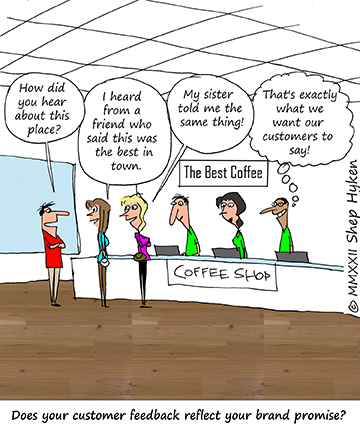 There are many definitions of the term brand. One of my favorites is this: A brand is a promised delivered.
There are many definitions of the term brand. One of my favorites is this: A brand is a promised delivered.
Is what you’re known for delivered consistently? Consider Ace Hardware, whose is The Helpful Hardware Place. When you visit an Ace Hardware store, do they keep their promise? Are they helpful? Based on all their awards and the comments from happy customers posted on social channels, they deliver.
Those comments and awards are what I refer to as The Echo. As you “shout” your brand promise, the feedback you get in return is the echo. And you want that echo to reflect your words.
The only way your customers will say what you want them to say – as in The Echo – is if the experience you deliver aligns with the brand promise. And it’s the customer’s perception that counts, not yours. So when the customer’s perception of your brand is the same as what you want them to experience, you have delivered on your promise.
Consider this. You may or may not remember the Yugo, a Yugoslavian automobile manufacturer that became popular in the U.S. in the 1980s. What attracted people was the price – a very reasonable $3,995. The company marketed the car as “an appliance” for people who wanted a no-frills basic car to get them from point A to Point B.
But it wasn’t long before the hype that came from the marketing and advertising fell short. For example, one of Yugo’s TV commercials claimed the car “… will defeat competitors. Reliability is its second name. Dependability and safety now have a totally new meaning. … Your dream of a tough, dependable car can finally be fulfilled.”
Unfortunately, The Echo was the opposite of what they were promoting. What they promised was something akin to BMW’s slogan of The Ultimate Driving Machine. Instead, they became what one author refers to as The ultimate automotive failure.
By the way, BMW’s slogan, The Ultimate Driving Machine, is its brand promise and has been since the 1970s. Their story is rich with high levels of luxury and engineering. And most of their customers perfectly echo the brand, as it delivers on its promise.
So, how are you and your company or brand perceived? Do your customers’ perceptions of your brand echo yours? Don’t answer me here. Ask the question in a room with your employees. See what they say. Then ask your customers. Hopefully, they match … a perfect Echo!
Shep Hyken is a customer service expert, keynote speaker, and New York Times, bestselling business author. For information on The Customer Focus customer service training programs, go to www.thecustomerfocus.com. Follow on Twitter: @Hyken
customer service training programs, go to www.thecustomerfocus.com. Follow on Twitter: @Hyken
The post The Echo appeared first on Shep Hyken.
October 18, 2022
Amazing Business Radio: Susan Drumm
 The Leader’s Playlist
The Leader’s PlaylistHow Memories, Experiences, and Patterns Impact Leadership Style
Shep Hyken interviews Susan Drumm, CEO & Chief Empowerment Officer of Meritage Leadership Development and the author of The Leader’s Playlist: Unleash the Power of Music and Neuroscience to Transform Your Leadership and Your Life. She shares how to use music to improve your leadership style and make the changes that no longer serve you.






 Top Takeaways:Our childhood “wounds” show up in the way we lead others. Leaders don’t just react based on what is happening at the moment. Some reactions are triggered by old patterns and experiences.Old memories and experiences are deep-seated patterns that trigger different reactions in different leaders, even when they face a similar situation. These patterns become the leader’s “internal playlist.”A leader’s internal playlist is the “music” playing in the background. It sets up how leaders see themselves and the world. It shows up in their leadership styles and how they work with their employees.The leader’s playlist affects the employee experience. This playlist, based on past experiences, impacts the way a leader acts toward people (employees), which eventually trickles down to the customer experience.How you retain and engage your employees, how your company is doing, how you show up for your family, and how you feel about yourself are all symptoms of an underlying playlist of how you view the world.Plus, Susan Drumm reveals the top song on her internal playlist. Tune in!Quotes:
Top Takeaways:Our childhood “wounds” show up in the way we lead others. Leaders don’t just react based on what is happening at the moment. Some reactions are triggered by old patterns and experiences.Old memories and experiences are deep-seated patterns that trigger different reactions in different leaders, even when they face a similar situation. These patterns become the leader’s “internal playlist.”A leader’s internal playlist is the “music” playing in the background. It sets up how leaders see themselves and the world. It shows up in their leadership styles and how they work with their employees.The leader’s playlist affects the employee experience. This playlist, based on past experiences, impacts the way a leader acts toward people (employees), which eventually trickles down to the customer experience.How you retain and engage your employees, how your company is doing, how you show up for your family, and how you feel about yourself are all symptoms of an underlying playlist of how you view the world.Plus, Susan Drumm reveals the top song on her internal playlist. Tune in!Quotes:“The brain is malleable. Even the deepest-seated patterns can be shifted with practice, and music is your brain hack to make it happen.”
“How music impacts a person is very personal. It is not about the genre of music that you listen to or include in your internal playlist. It is about what emotional state that music puts you in.”
About:Susan Drumm is a keynote speaker, CEO, and Leadership Coach. She is the host of The Enlightened Executive, Chief Empowerment Office of Meritage Leadership Development, and the author of The Leader’s Playlist: Unleash the Power of Music and Neuroscience to Transform Your Leadership and Your Life.
Shep Hyken is a customer service and experience expert, New York Times bestselling author, award-winning keynote speaker, and host of Amazing Business Radio.
This episode of Amazing Business Radio with Shep Hyken answers the following questions and more:
What is “The Leader’s Playlist”?What songs should be on your internal playlist?How do you leverage music to improve leadership?How do past experiences affect leadership styles?How do you change behavior patterns that hold you back from being a good leader?The post Amazing Business Radio: Susan Drumm appeared first on Shep Hyken.
October 17, 2022
5 Top Customer Service Articles of the Week 10-17-2022
Each week I read many customer service and customer experience articles from various resources. Here are my top five picks from last week. I have added my comment about each article and would like to hear what you think too.
Enough Already With Customer Feedback. Make Your Move by Jeb Dasteel(CMS Wire) Surveys, especially, will ultimately bury you with customer malcontent and your own frustrated inaction. Should we ignore customers and what their needs are? Of course not. However, we do spend an awful lot of time collecting and measuring sentiment — and not nearly enough time engaging with customers in more impactful ways.
My Comment: I’ve always believed that surveys are very important. They are a history lesson of the customer’s most recent experience. Typically the data comes in the form of numbers, such as NPS or CSAT. However, there is a more important number, and that is the future sales of the customer. In other words, does the customer come back? This article pokes hard at the people/companies that are fixated on surveys – and suggests doing something more important than looking at numbers.
For Incredible Results: Surprise and Delight Your Most Devoted Customers by Laura Bassett(CMS Wire) Who comes back for average customer experience? Nobody. Every interaction with a customer is a loyalty test. Customers expect in-store service whether their journeys start in search, include a chatbot or end with an agent conversation. These new, high service expectations leave businesses scrambling to deliver ideal service experiences across multiple entry points in customer journeys and in digital channels like apps, chat and self-service.
My Comment: I love the opening line of this article: “Who comes back for average customer experience? Nobody.” The author, Laura Bassett from NICE, and I are in sync with the idea that every interaction with a customer is an opportunity. Bassett says those interactions are loyalty tests. I love this concept. I don’t see enough companies breaking down the customer journey and examining every interaction point – but they should.
9 Commandments Of Client Service by Eric Gilbertsen(Forbes) What is it that bonds clients to partners when so many alternatives exist? When does a vendor become a strategic partner, no longer at arm’s length but seated at the table?
My Comment: I love this list. Nine specific ideas, tips, strategies, and/or tactics (whatever you want to call them – even commandments) that will create a better customer or client experience. You will agree with all of them, and you already know them. Still, read them and consider if you’re really executing on each one. And after you read the article, share it with your team.
Retention Signals Success for Subscription Businesses by Guy Marion(Total Retail) For subscription businesses, customer retention could be seen as just as important as customer acquisition, if not more. Strong retention strategies can improve average order values, drive purchase frequency, and even expand your reach through referrals and word-of-mouth.
My Comment: Have you ever noticed how your Internet/cable company offers first-time customers a much better “deal” than existing long-term customers? I’ve always preached you have to treat your existing customers at least as well, if not more so. This article approaches that topic and suggests the same. And you don’t have to be in the subscription business for this to apply. Yes, we want to get new customers. We also want to keep the ones we have.
A Decade of Dramatic Change in Digital Customer Experience by Scott Clark(CMS Wire) The digital customer experience has exponentially evolved over the past decade, hurried along by the COVID-19 pandemic. Due to the huge increase in the number of digital interactions the typical customer has had over the past few years, customer expectations have grown while customer patience has decreased. The always-on customer expects brands to be ready to do business at all hours of the day, and they expect exceptional customer service to go with it.
My Comment: Think about the technology that has changed our lives in the past 50 years (if you’re that old). The microchip is behind much of this. There wasn’t an Internet before the ’80s (at least not one the public was using). There weren’t small mobile phones where the most important functions had nothing to do with a phone. The list can go on and on. This article looks at some major changes in customer experience, specifically the digital customer experience. Looking back over the past ten years, much has changed – and improved!
[image error]Shep Hyken is a customer service expert, professional speaker, and New York Times bestselling business author. Go to The Customer Focus to learn more about our customer service training programs. Follow on Twitter: @Hyken
to learn more about our customer service training programs. Follow on Twitter: @Hyken
The post 5 Top Customer Service Articles of the Week 10-17-2022 appeared first on Shep Hyken.
October 14, 2022
Guest Post: Cultivate a Customer Service Online Training
This week, we feature an article by Christopher Jan Benitez, a freelance writer who specializes in digital marketing. He shares the importance of developing online training resources for your customer service team and how to implement one for the success of your business.
Your customer service team must be an asset to your organization. They should help provide quick service, sustain positive customer relationships, and help address concerns prospects have from becoming one.
The best customer service doesn’t have to work together in the same room. Your team can be composed of different people across the globe and can provide excellent support to your clients.
However, this is only possible if they are trained the right way.
Why Your Customer Service Needs Online TrainingOnline training for your customer service is essential for various reasons:
Helps them become better brand advocates – Customer service is your frontline when talking to leads and customers about your business. Their knowledge about your business and their disposition influences people also to have a positive attitude toward your brand. Increases customer loyalty – After turning people into customers, the real work begins by keeping them as one. Customer service helps by ensuring all their needs are met and questions answered. In doing so, there’s no reason for them to leave! Gain a competitive advantage – Having a great product and service for sale is good. But having customer service that treats customers like real people and humanizes your brand is even better. How to Build an Effective Customer Service Online TrainingBelow are ways to help your organization develop solid online training in place for your customer service team:
Determine Customer Training Type
There are various ways you can train your online customer support staff. New hires undergo an onboarding process that includes training. Aside from getting to know the team, the training introduces your products and services and sets expectations based on their responsibilities to avoid confusion among the team.
Over time, you may want a quarterly or annual team review to ensure everybody’s in sync and clicking on all cylinders. You can determine this by referring to the North Star metrics when reviewing each. This also serves as a re-training—revisit some of your training that your team isn’t proficient in or supply additional training to ramp up their performance.
Finally, you want to call emergency training for new or updated products you’re offering. This enables your customer support to answer queries about them correctly.
Use the Best Materials for Training
Aside from product and service information and company background, your training materials should teach you how to become a better customer support agent. In addition, it should instill skills like interpersonal communication, crisis management, and conflict resolution to help them solve leads and customers’ issues with your organization.
And since customer support never ends, so should your efforts in helping them continuously provide better services to customers. To do this, you must extract information from people who talked to your customer support regarding their experience. Then, after every interaction with your team, ask people to take assessments containing questions about their experience.
Use their feedback to focus on areas of improvement to be integrated into your training.
Simulate Calls
Let’s face it: as efficient as automated customer service is, nothing beats the personal touch of an actual human on the other line.
So, to help put their training into practice, you want your team to take up mock calls simulating new or difficult scenarios regarding your business.
For example, simulate a call with branching scenarios to see how your customer responds to each. Recreating these situations helps them get used to the pressure from leads or customers. This way, they can provide them with the appropriate response without getting rattled. Since there can be unlimited scenarios that could happen in a call, your team may not be able to respond correctly to each instance. In this case, you can diagram the most common scenarios into an easy-to-follow flowchart that your team can use as a guide during calls.
The call simulation and data from actual calls should help identify which scenarios you must diagram in the flowchart. At best, you want your team to be able to manage customer expectations from these calls. Even if they could not hit the goals, encourage your team to at least make an effort to help customers.
ConclusionMost businesses neglect customer support for various reasons. Because they prioritize getting new clients, taking care of existing ones goes by the wayside. On the contrary, investing in online customer support allows your organization to cultivate relationships with current customers, turning them into loyal brand advocates.
At the same time, you can use customer support to introduce prospects to the business, which could convince them to become clients. Again, this can only be possible if you have a robust online training program, which we have detailed above.
Christopher Jan Benitez is a freelance writer specializing in digital marketing. His work has been published on SEO and affiliate marketing-specific platforms.
 For more articles from Shep Hyken and his guest contributors, go to customerserviceblog.com.
For more articles from Shep Hyken and his guest contributors, go to customerserviceblog.com.
Read Shep’s latest Forbes article: The Power Of Instagram
The post Guest Post: Cultivate a Customer Service Online Training appeared first on Shep Hyken.
October 12, 2022
The Best Social Media Channels for Customer Service
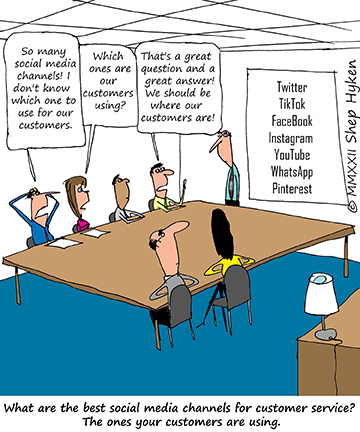 Social customer care may not be the most popular channel to deal with customer issues for most businesses, but that doesn’t mean it’s not important. More and more customers are turning to social media to get help. More on why in just a moment. For now, let’s address why companies aren’t using social channels.
Social customer care may not be the most popular channel to deal with customer issues for most businesses, but that doesn’t mean it’s not important. More and more customers are turning to social media to get help. More on why in just a moment. For now, let’s address why companies aren’t using social channels.
When a company tells me they don’t want to participate in social media customer care, I ask why. They have explanations – notice I didn’t use the word excuses, but that is really what they are. The explanations are:
We steer them to the phone, so we don’t need any other channels. We don’t have the staff to handle all the different social channels. We don’t have the budget to expand our customer support department. And more, but the excuses – I’m sorry, explanations – aren’t important.Our annual customer service research shows that of all the ways customers reach out for customer support, social media channels like Twitter, Facebook, Instagram, and others are at the bottom of the list, but that doesn’t mean they should be ignored.
The phone has always been the most popular channel for support. Why? Because it’s always been there. But now, there are options such as email, chat, apps and more. Gen-Z and Millennials are the catalysts for digital customer support channels.
Rob Siefker, Zappos.com’s former senior director of customer loyalty, shared his take on social media channels in a recent Inc. article. When asked why Zappos uses social media, his answer was, “Zappos customers use it. All we do is decide if we want to be in that space.” He also said, “Customers call us, but we didn’t invent the phone.”
That last sentence says it all! “Customers call us, but we didn’t invent the phone.” None of us invented the social channels, either. His point is that just because we didn’t invent it, doesn’t mean we shouldn’t use it, especially if our customers want us to.
Earlier, I promised to share the why – or the reason customers are turning to social media. While more and more are using social media channels like Twitter and Facebook, it’s not always their first choice. Unfortunately, it’s where customers go because the company didn’t make it easy to call or didn’t respond to their emails or text messages. So, they “go social” and post on Twitter, Facebook, and other social platforms. That’s a terrible reason! And by the way, the rest of the world can see these posts. And if you choose not to respond, your customers might notice.
Yet, despite that terrible reason, you should still be on social. If you haven’t already noticed, you will start to see more and more customers commenting, asking questions, and complaining on social channels. And you need to respond to them. Watch where your customers are and be there for them.
What are the best social media channels for customer service? The ones your customers are using.
Shep Hyken is a customer service expert, keynote speaker, and New York Times, bestselling business author. For information on The Customer Focus customer service training programs, go to www.thecustomerfocus.com. Follow on Twitter: @Hyken
customer service training programs, go to www.thecustomerfocus.com. Follow on Twitter: @Hyken
The post The Best Social Media Channels for Customer Service appeared first on Shep Hyken.
October 11, 2022
Amazing Business Radio: Temy Mancusi-Ungaro
 Creating Employee Morale Through Gifting
Creating Employee Morale Through GiftingHow Happy Employees Translate Into Happier Customers
Shep Hyken interviews Temy Mancusi-Ungaro, Chief Executive Officer of Reachdesk, a global data-driven gifting platform that helps teams send gifts at a large scale and measure their impact. He shares how companies can use gifts to create employee morale, nurture team connections, and ensure employee retention.






 Top Takeaways:From an employee’s onboarding to celebrating work anniversaries, birthdays, and promotions, a meaningful gift is a great way to create morale.Now that the workplace has undergone a migration where employees have gone partially or fully remote, it has become harder to forge relationships. Personalized and timely gifts are an excellent way for employers to show they care for their employees as humans and that they want to invest in their work experience.If you are dealing with a hybrid or fully remote workforce, people become disconnected from your company. However, just because they aren’t there doesn’t mean they want to be disconnected. Something as simple as an inexpensive gift and some company swag can make them feel excited and connected to something bigger.Personalize gifts… When you receive gifts, the ones you will keep are those that resonate with you. It is all about the meaning behind it that creates a personal connection.Employees need to feel connected and supported. Gifting is a great way to deliver moments that matter, build a connection, and support your employees.Plus, Shep shares some of the best corporate gifts that he has received. Tune in!Quotes:
Top Takeaways:From an employee’s onboarding to celebrating work anniversaries, birthdays, and promotions, a meaningful gift is a great way to create morale.Now that the workplace has undergone a migration where employees have gone partially or fully remote, it has become harder to forge relationships. Personalized and timely gifts are an excellent way for employers to show they care for their employees as humans and that they want to invest in their work experience.If you are dealing with a hybrid or fully remote workforce, people become disconnected from your company. However, just because they aren’t there doesn’t mean they want to be disconnected. Something as simple as an inexpensive gift and some company swag can make them feel excited and connected to something bigger.Personalize gifts… When you receive gifts, the ones you will keep are those that resonate with you. It is all about the meaning behind it that creates a personal connection.Employees need to feel connected and supported. Gifting is a great way to deliver moments that matter, build a connection, and support your employees.Plus, Shep shares some of the best corporate gifts that he has received. Tune in!Quotes:“In the same way that we use gifts to build relationships for sales, you can use gifts to build relationships within your employees.”
“Every dollar I spend on my people, I get $10 in return. The more I invested in my employees, the better my customer service becomes.”
“Invest in your people. Your customers will feel it, and your business will ultimately feel it in the end.”
About:Temy Mancusi-Ungaro is the Chief Executive Officer of Reachdesk, the leading global data-driven gifting platform. He has over 20 years of experience scaling SaaS companies and leading customer and employee success.
Shep Hyken is a customer service and experience expert, New York Times bestselling author, award-winning keynote speaker, and host of Amazing Business Radio.
This episode of Amazing Business Radio with Shep Hyken answers the following questions and more:
Why is company morale important?How can workplaces create company morale through gifting?Is employee experience as important as customer experience?How can I boost morale while working remotely?How do you make an employee feel supported?The post Amazing Business Radio: Temy Mancusi-Ungaro appeared first on Shep Hyken.
October 10, 2022
5 Top Customer Service Articles of the Week 10-10-2022
Each week I read many customer service and customer experience articles from various resources. Here are my top five picks from last week. I have added my comment about each article and would like to hear what you think too.
7 Tips for Successfully Embedding Customer-centric Governance Into Company DNA by Meygan Gerber(EHL Insights) Today’s business world requires companies to put customers in the driving seat. Nurturing customer relationships is the secret to boosting your customer lifetime value, cutting down churn, leaving your competitors in the dust, and catapulting your business growth. Usher in customer-centricity. We see you wondering, “What is it and how can you hack it?”
My Comment: Customer Centricity is an often used yet misunderstood term. I like this article’s definition: ”Customer-centricity is a business approach where you prioritize your customer and place them at the heart of your business operations. The goal is to offer positive experiences and build life-long relationships.” I’m almost in agreement. Not every decision, such as a price increase, is going to make the customer happy. My take is that we consider the customer with every decision. Even if it won’t make the customer happy, you have at least considered the impact. That said, this article has some great takeaways, especially if you want to be a customer-centric organization.
Five Emotional Intelligence Customer Service Skills To Help Employee Retention by Roberta Moore(Forbes) What do you do when you have numerous stores to run, loyal customers to keep satisfied and a pandemic that causes people to drop out of the workforce in droves? This was the question on the minds of owners/operators of a major fast-food chain, 26 of whom I worked with in southern Illinois and the eastern central Missouri area. Much like many restaurant owners across the nation, these regional owners were understaffed and facing high turnover rates of more than 200% over the past 12 months.
My Comment: Emotional intelligence has been a hot topic over the past few years. Used in a customer service and support setting, it is a powerful way to make your customers connect with you and ideally return for more. The author shares five “skills” that will help build relationships with your customers; stress tolerance, self-actualization, assertiveness, interpersonal relationships, and happiness.
The Experience Advantage: How to Supercharge Your Brand’s Growth by Peter Aitken(Kantar) How can brands make sure that their customer experience (CX) is different to competitors? Great customer experiences have a direct impact on business value, driving both revenue and cost savings.
My Comment: Who doesn’t want to supercharge the customer experience? Here’s a stat quoted in the article: “91% of CEOs agree that customer centricity – making the customer experience as brilliant as it can possibly be – is essential for driving business growth. The less good news? Only 20% of customers rate these business leaders’ brands as being truly customer-centric.” That’s a big gap, and the strategy behind it is to “Mind the Gap.” And there’s several other thoughts and ideas in this excellent article.
The Secret to Building Brand Devotion is Not a Loyalty Program. Here’s What Customer’s Really Want. by Andrew Reid(Entrepreneur Media) The idea of consumer loyalty has been around for centuries. But with a growing consumer appetite for privacy and control, it may be time to rethink the traditional brand relationship.
My Comment: I’ve always preached that there is a difference between a repeat customer and a loyal customer. Often, companies believe they will create loyalty from loyalty programs. Those programs may get customers to come back, but that doesn’t mean they are devoted to you. They could be devoted to just your loyalty program. What happens if you take away the loyalty program? Do they stop doing business with you? They might. So consider what you really want. Is it a loyal customer, or is it a devoted customer?
How to Improve Your Website’s Customer Experience (CX) by Wise Marketer Staff(The Wise Marketer) In the era of the customer, companies are hyper-focused on providing amazing experiences at every touchpoint to differentiate themselves from the competition. One of the most important touchpoints to improve Customer Experience (CX) is your website since it is often the first point of interaction a potential customer has with your brand.
My Comment: This article makes a bold statement: “Many businesses fall short when it comes to providing a great CX on their website.” My thought on this is that the website is designed by people to be used by people. Keeping that in mind should help as you design the site’s experience. The author suggests focusing on accessibility, including live chat, sharing customer testimonials, and ensuring the site is fast.
BONUSWhat Has Changed in Customer Service? by itelCX(itelCX) For Customer Service Week, we sit down with New York Times bestselling author and renown customer service and customer experience (CX) expert, Shep Hyken, to discuss all things CX, including what has changed in customer service, and the shifting landscape of customer expectations.
My Comment: Our friends at itel interviewed me for Customer Service Week (which just ended). They asked some great questions – and I hope that they were happy with the answers. We talked about everything from removing friction, how fast customers will leave after just two or three mistakes, building trust, and more.
CX Podcasts That Bring Real Value by Uniphore(Uniphore) CX is one of today’s top business priorities. And it’s easy to see why. One of the keys to. One of the keys to having a successful business is having loyal customers who enjoy their interactions with you, always going back for more. CX can be difficult to nail down for some during this post-pandemic age of change, but we’re here to help.
My Comment: Last week, I shared a list of top podcasts in the CX space. This week Uniphore shared their lists of CX podcasts that bring the most value. Amazing Business Radio showed up again. Thank you, Uniphore, for including me on this list of amazing shows!
[image error]Shep Hyken is a customer service expert, professional speaker, and New York Times bestselling business author. Go to The Customer Focus to learn more about our customer service training programs. Follow on Twitter: @Hyken
to learn more about our customer service training programs. Follow on Twitter: @Hyken
The post 5 Top Customer Service Articles of the Week 10-10-2022 appeared first on Shep Hyken.
October 6, 2022
Guest Post: The Biggest Value Driver That is Not on Your Journey Map
This week, we feature an article by Zhecho Dobrev, leading principal consultant at Beyond Philosophy and author of The Big Miss: How Organizations Overlook the Value of Emotions. He shares the value that customer emotions bring to a company.
How much value ($$$) do closer customer relationships and specific customer emotions bring to your business? I know you would say, “of course that these are important, and we focus on them,” but have you calculated how much value they actually bring? In over 13 years of practice working with many organizations on their customer experience (CX) programs and having seen the type of research and measurements they do, I’ve only come across a handful of organizations that can prove to you how much value customer emotions bring to the company.
Why is this important, you might ask? Well, again, my observations show that pretty much every team tasked with improving the customer experience and driving more sales and customer retention is doing some form of journey mapping. And they should as it’s probably the cheapest and simple way of finding opportunities to improve the customer experience. The problem I see is this. Where do customer relationships feature on those journey maps? The other problem is that most teams pay superficial attention to customer emotions, mainly focusing on the customer steps/actions in the experience.
Consider this mindblowing fact from a Gartner research. Gartner provides various statistics showing that reducing customer effort can greatly impact customer retention and even reduce costs. The interesting part is that they report that 59% of the Customer Effort Score (CES) is driven by how customers feel, while 73% of CX teams focus on what customers objectively experience, not on how customers feel. This just shows that organizations overlook emotions probably because they don’t know how to have a data and science-based approach towards evoking specific emotions that, in turn, will drive value for the business.
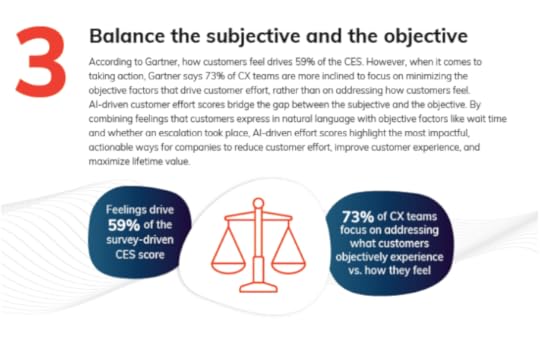
Source: Gartner
With these questions and thoughts in the back of my mind, I decided to turn to our data of research with many organizations and calculate the value of customer emotional attachment compared to the typical customer journey map touchpoints.
The research sample consisted of data collected from some 18,537 customers of 24 large organizations from 9 different industry sectors, and the analysis included conducting structural equation modeling predictive analysis on 59 customer groups. In the process, B2B and B2C customers from the US, Canada, UK, Europe, the Middle East, and East Asia answered 1m+ survey questions. The research culminated in my book “The Big Miss: How Organizations Overlook The Value of Emotions” (Business Expert Press, 2022).
We found that “Emotional attachment” was the biggest driver of value in 59% of the customer groups we analyzed and overall was responsible for 43% of business value – far more than 2nd ranked “Product and use” with 20% and 3rd ranked “Brand and advertising” with 18%.
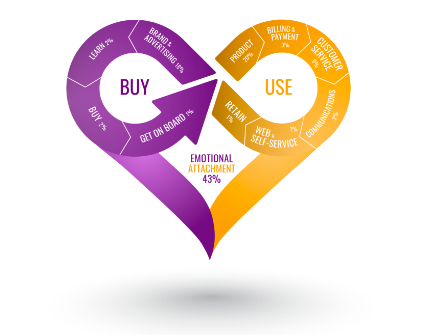
When we say “drive value for organizations,” what we mean is customers being more likely to recommend the organization, buy from them again or renew their subscription, contract, or insurance policy, seeing the organization as easy to work with (which research suggests is a predictor for future financial performance) and seeing the organization as distinctively better than competitors.
Of course, I am far from saying that I “discovered America” with this research. I have a dedicated chapter to research from other organizations with similar findings in the book. The point for me is this – despite the overwhelming evidence that emotions play a key role in customer decision making and the degree of emotional connection with the brand determines subsequent customer behavior, few organizations have a structured and wholistic approach towards nurturing such an emotional attachment.
The next interesting finding from our research might explain why this is the case. Customers don’t say that emotions are important to them!
When we do our Emotional Signature research, we use Maximum Difference Scaling (Most Important vs. Least Important) to find what customers want most and predictive analytics to find the key drivers of business value (customer attitudes). This way, we found that in 74% of the customer groups we analyzed, customers stated Product as the most important for them. In reality, the predictive analytics structural equation model showed that the Product only accounts for 12% of the largest drivers of value. On the other hand, only 2% of customer groups we analyzed customers stated an “Emotional attachment” aspect as the most important, while “Emotional attachment” accounts for 59% of the largest drivers of value.
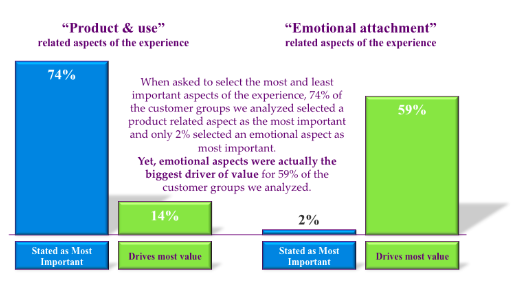
This finding from the research confirms the words of David Ogilvy, who famously said, “Consumers don’t think about how they feel. They don’t say what they think, and they don’t do what they say”. However, the way most organizations do research with customers largely ignores this and often leads to costly mistakes (find some examples of costly mistakes in this article). So organizations need to dig deeper with their research methodologies to find the emotional and subconscious drivers of customer attitudes and behavior.
Focus on building an emotional attachmentAt the moment, when organizations use Journey Mapping, they focus on the customer actions and the rational side of the experience. They try to smooth the journey and find opportunities for digital automation.
As our research suggests, in addition to completing the jobs they set to do, customers also have the inner desire to feel a sense of belonging, that they are valued and appreciated as customers and that the organization they buy from cares for them as individuals and is trustworthy.
Organizations should rethink their journey maps and moments of truth to look at what customers are trying to do and how they are using the various interaction touchpoints as opportunities to create an emotional connection and a feeling of a relationship.
Zhecho Dobrev is a customer experience and behavior science consultant & trainer at Beyond Philosophy and the author of The Big Miss: How Organizations Overlook the Value of Emotions. For more than 13 years, he has been helping many of the world’s most renowned organizations improve their customer experience, including American Express, FedEx, and Caterpillar.
 For more articles from Shep Hyken and his guest contributors, go to customerserviceblog.com.
For more articles from Shep Hyken and his guest contributors, go to customerserviceblog.com.
Read Shep’s latest Forbes article: Selling With Service: Five Sales Lessons From A Harvard Business School Professor
The post Guest Post: The Biggest Value Driver That is Not on Your Journey Map appeared first on Shep Hyken.



